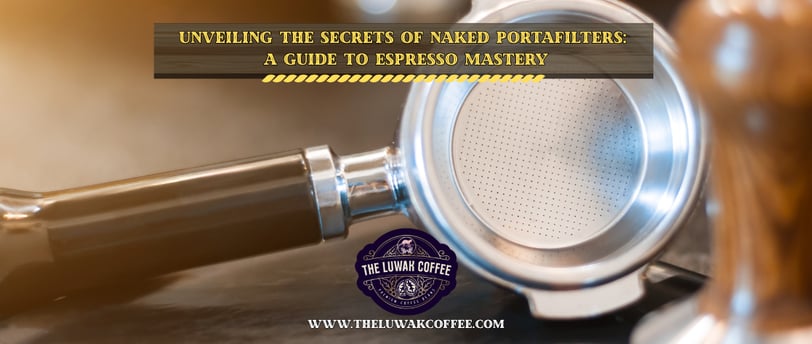CERTIFIED WILD LUWAK COFFEE, 100% WILD

Unveiling the Secrets of Naked Portafilters: A Guide to Espresso Mastery
ESPRESSO-RELATED
2/21/20258 min read



Introduction to Naked Portafilters
Naked portafilters, often referred to as bottomless portafilters, represent a distinctive advancement in espresso equipment that has garnered enthusiasm among coffee aficionados and professional baristas alike. Unlike traditional portafilters, which typically feature spouts directing the flow of espresso, naked portafilters possess a unique design characterized by their open-bottom structure. This innovative approach not only enhances espresso extraction but also allows for a clearer view of the brewing process.
The absence of spouts in naked portafilters affords users an opportunity to observe the espresso as it emerges directly from the coffee basket. This transparency is crucial for baristas looking to perfect their technique, as it provides immediate feedback on the quality of the extraction. With the naked portafilter, any irregularities in the flow or channeling can be spotted instantly, leading to more informed adjustments and ultimately superior espresso.
Naked portafilters are particularly favored due to their aesthetic appeal and practical utility. The unfiltered view of the espresso creates a mesmerizing visual effect, showcasing the rich crema and the vibrant hues that characterize a well-pulled shot. Additionally, this design promotes a greater understanding of the espresso-making process, as baristas can see the nuances of extraction firsthand, fostering an environment conducive to learning and improvement.
In recent years, the popularity of naked portafilters has surged, partly due to the expressive nature of the espresso it produces. Enthusiasts appreciate the control these portafilters offer, enabling them to hone their skills and explore the various flavor profiles that different coffee beans can yield. As we delve further into the secrets of naked portafilters, we will uncover the intricacies that make them an essential tool for those seeking espresso mastery.
Benefits of Using a Naked Portafilter
Naked portafilters, also known as bottomless portafilters, have gained popularity among espresso enthusiasts and professional baristas alike due to their distinct advantages in the brewing process. One of the primary benefits is the improved extraction visibility they offer. Unlike traditional portafilters, which direct the coffee flow through spouts, naked portafilters allow baristas to observe the entire extraction process from the group head. This transparency is crucial for diagnosing extraction issues, helping baristas to make real-time adjustments to grind size, dose, and tamping pressure for optimal results.
Moreover, using a naked portafilter significantly enhances crema production. Crema is the golden, foamy layer on top of a shot of espresso that indicates a well-extracted coffee. The open design of the naked portafilter enables the coffee to flow freely into the cup, promoting a richer and more voluminous crema as the coffee oils emulsify. The visibility allows baristas to assess the quality of the crema immediately, ensuring the espresso meets high standards before serving.
In addition to these benefits, naked portafilters foster better barista training and skill development. By utilizing this tool, novice baristas can easily identify brewing errors such as channeling or uneven extraction, which may not be as apparent with regular portafilters. This hands-on experience facilitates a deeper understanding of espresso mechanics, empowering baristas to improve their techniques effectively. As they refine their skills, the consistency and quality of the espresso shots produced will naturally improve, resulting in a more satisfying experience for both the barista and the customer.
How to Use a Naked Portafilter Effectively
Using a naked portafilter is pivotal for those aiming to master espresso brewing. To fully harness its capabilities, proper preparation and technique are essential. Begin by ensuring your equipment is clean. A dirty portafilter can significantly affect flavor extraction, making it crucial to start with a spotless tool. Next, select high-quality coffee beans, preferably freshly roasted, as they deliver the best results. The freshness of the beans directly correlates with the richness of the espresso.
Once your beans are selected, proceed to grind them to a fine consistency. The grind size is paramount; too coarse will result in a weak extraction, while too fine may lead to bitterness. Dosing is the next crucial step, typically requiring between 18 to 20 grams of coffee for a double shot, but this can vary based on personal preferences. Utilize a scale for precision and consistency in your measurements.
After dosing, distribute the coffee grounds evenly in the portafilter basket. An even distribution is critical to ensure uniform water flow during the brewing process. Tamping is the next stage; apply firm and even pressure while tamping down the coffee. This step helps to create a solid puck, allowing the water to extract flavor evenly. Be cautious to avoid common mistakes such as tamping unevenly or not applying sufficient pressure, as these can lead to channeling and inconsistent extraction.
Once tamped, attach the naked portafilter to your espresso machine. Start the extraction process while closely monitoring the time. Ideally, a double shot should take between 25 to 30 seconds. Pay attention to the flow of espresso; it should start as a rich, golden stream, and any deviations from this indicate potential issues with your grind size, tamping, or dosage. By following these steps and maintaining attention to detail, mastering the use of a naked portafilter becomes an attainable goal for espresso enthusiasts.
Troubleshooting Espresso Shots with a Naked Portafilter
Using a naked portafilter can significantly enhance the espresso-making experience, yet it also presents unique challenges. One of the most common issues encountered is channeling. Channeling occurs when water travels through the coffee puck unevenly, resulting in a subpar extraction. This phenomenon is often indicated by the presence of uneven streams or spurting coffee. To address channeling, it is crucial to ensure that the coffee is evenly distributed in the portafilter. Using tools such as a distribution tool or a simple tapping technique can help create a more uniform surface for even extraction.
Another frequent challenge is uneven extraction, which can lead to a bitter or sour taste in the final shot. Factors contributing to this problem include inconsistent grind size and tamping pressure. Ensuring that the coffee grounds are uniform is essential; consider using a grinder known for its consistency. A finer grind may enhance the extraction, but it also increases the risk of channeling. It is generally recommended to experiment with grind settings to find the ideal balance that results in a rich and balanced flavor profile.
Additionally, the impact of grind size cannot be understated. If the grind is too coarse, the water may flow through too quickly, leading to under-extraction. Conversely, a grind that is too fine can result in over-extraction, yielding a bitter espresso. Adjusting the grind size based on the specific coffee beans and desired flavor profile is a vital skill for any barista. It involves a degree of experimentation and practice, but mastering this aspect can greatly improve the quality of your shots.
By addressing these common issues—channeling, uneven extraction, and grind size—baristas can refine their skills and enjoy the full potential of their naked portafilter. Implementing these troubleshooting techniques paves the way for consistently great espresso shots.
Cleaning and Maintenance of Naked Portafilters
Proper cleaning and maintenance of naked portafilters are crucial for ensuring not only the longevity of the equipment but also the quality of espresso produced. Unlike traditional portafilters, naked portafilters offer greater visibility, allowing baristas to inspect the extraction process. However, this transparency means that any residues or build-up are more noticeable, underscoring the need for diligent care.
To begin with, it is essential to remove the basket from the portafilter after each use. Rinse the basket and the portafilter under warm water to clear out the coffee grounds and oils. Utilizing a brush designed for coffee equipment can help get rid of stubborn residue. It is advisable to choose a brush with soft bristles to avoid scratching the surface of the portafilter.
For deeper cleaning, consider soaking the portafilter in a solution composed of water and biodegradable coffee cleaner. This process can eliminate oils that may linger from previous uses. After soaking, a thorough rinse is necessary to ensure no cleaning solution remains, which could negatively impact the flavor of the espresso. Additionally, using a microfiber cloth to wipe down the exterior of the portafilter will keep it looking polished.
Regular maintenance of the rubber gasket and group head is also critical. Every few weeks, inspect the gasket for wear and replace it if signs of damage are detected. This simple act can prevent leaks and maintain proper pressure during extraction. It’s equally important to occasionally backflush the espresso machine to remove any build-up in the group head, ensuring optimal output from the naked portafilter.
In conclusion, the cleaning and maintenance of naked portafilters require a systematic approach. The combination of immediate post-use actions and regular deep-cleaning routines will lead to a noticeable improvement in both the performance and lifespan of the equipment, ultimately enhancing your espresso-making journey.
Comparing Naked Portafilters to Traditional Portafilters
The world of espresso making is characterized by diverse equipment options, particularly when it comes to portafilters. At the forefront of this equipment debate are the naked portafilters and their traditional counterparts. Understanding the distinctive features and functionalities of each type can significantly influence one's espresso-making journey.
Traditional portafilters, typically fitted with spouts, are the most common choice among baristas and home enthusiasts alike. They serve the pivotal purpose of holding the ground coffee and allowing the brewed espresso to flow into a cup. One of the primary strengths of traditional portafilters is their ability to minimize mess. The spouts direct the coffee flow, preventing it from splattering onto the machine or counter. Additionally, traditional portafilters are easier for beginners to use, as they provide visual guidance on how the brew is extracted.
In contrast, naked portafilters, also known as bottomless portafilters, lack spouts and feature an open design. This allows for a unique visual experience during extraction, showcasing the espresso’s flow and crema production. The clarity of the extraction process aids baristas in identifying issues related to grind size, tamping pressure, and distribution. Furthermore, naked portafilters promote a more uniform extraction by allowing coffee oils and aromas to escape freely, significantly enhancing the flavor profile of the espresso.
However, naked portafilters require a certain level of skill and technique, often posing challenges for those new to espresso making. The absence of spouts can lead to messy extraction if not managed properly, as coffee may splatter during the process. Consequently, users must be willing to invest time in practice and fine-tuning their skills. In conclusion, the choice between naked and traditional portafilters fundamentally hinges on individual preferences, skill levels, and desired espresso experience. Each type has its merits; evaluating these can lead to informed decisions about the best equipment for crafting exceptional espresso.
Conclusion: Embracing the Naked Portafilter Revolution
In the ever-evolving landscape of espresso preparation, the naked portafilter has emerged as a pivotal tool that significantly enhances the brewing experience. This innovative instrument not only allows for the visual enjoyment of the extraction process but also serves as a critical aid in refining one’s skills and understanding of espresso brewing. Through the transparency it offers, practitioners gain insights into various parameters, such as flow rate and extraction consistency, which are essential for crafting the perfect espresso shot.
Utilizing naked portafilters provides several distinct advantages. Primarily, they enable baristas and coffee enthusiasts to identify and rectify potential extraction issues. By observing the coffee's behavior as it flows through the filter, users can quickly determine if adjustments need to be made regarding grind size, tamping pressure, or dosing amounts. This hands-on approach lays the groundwork for a deeper appreciation of the intricate science behind espresso brewing and encourages a methodological exploration of espresso crafting techniques.
Moreover, the naked portafilter fosters an environment of experimentation. As coffee lovers embrace its application, they are more inclined to explore various coffee beans, blends, and grind settings, allowing for a personalized touch that enhances their palate. Each unique preparation encourages new insights and discoveries, building a rich tapestry of espresso experiences that deepen one’s knowledge and skills.
Ultimately, embracing the naked portafilter revolution is a step towards both mastery and enjoyment of espresso preparation. With its unparalleled ability to provide feedback and foster experimentation, the naked portafilter stands as a vital resource in the quest for espresso excellence. By integrating this tool into your routine, you pave the way for greater comprehension and an evolving passion for the art of coffee brewing.
